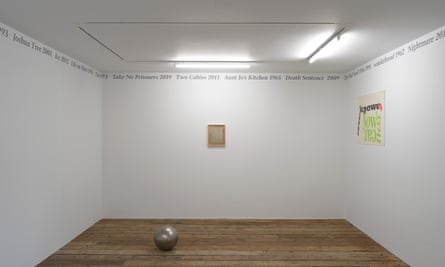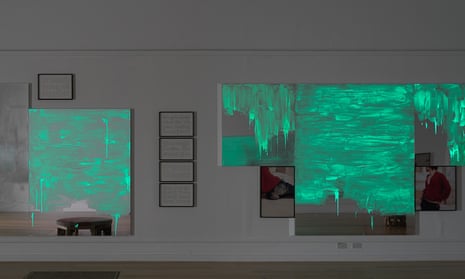Danh Vo’s is an art of coincidence: of people and places, history and anecdote, objects and images. Overwhelming in its complexity, Vo’s exhibition at the South London Gallery is further complicated by a concurrent show at Marian Goodman’s London gallery.
Born in Vietnam in 1975, Vo escaped with his family in 1979, in a boat built by his father that was picked up by a Danish vessel. This perhaps accounts to some degree for the role of serendipity and chance encounters in his art. Every work, every group of photographs, every object is an amalgam of stories, references and symbols. The SLG provides a useful commentary to Vo’s exhibition, which he calls Untitled; a lazy non-title you might say, until you realise that a reversal of his name to Vo Danh means unnamed or nameless in Vietnamese, the words often found on gravestones in the country, where so many died, unidentified, in the war with the US.
Accidents of history, chance encounters, confrontations and collaborations all play their part in Vo’s largest UK exhibition to date. Sometimes I feel I am drowning in its multiplicities. Whatever you grasp – a solid walnut cuboid, a hand-copied letter, a second-century Greek marble torso of Apollo in a little wooden crate that once held tins of Carnation milk – is itself a link in almost endless chain of associations.

Vo’s art is also filled with moments of loveliness and provocation. He is as much a provocateur as he is an aesthete. He can be sexy, sly, funny, harrowing and heartfelt, and some of his motifs – lines taken from William Friedkin’s 1973 demonic possession movie The Exorcist, or the last letter of a Jesuit missionary, written on the day of his execution in Vietnam in 1861 – recur often enough to make us feel that there is an ongoing narrative at work. The sacred and profane, guilt and redemption play their part.
Framed snatches of dialogue from The Exorcist abut paintings by Danish artist Peter Bonde, Vo’s former teacher at the Royal Danish Academy. As a student, Vo had a vexed relationship with his tutor, whose work he thought was too macho, while Bonde encouraged Vo to give up painting. Bonde often shows his paintings in a manner close to Vo’s installation here, butting-up large works and small, and playing with the autonomy of different elements. Bonde has been painting for some time on mirrored panels, leaving some areas of the surface unpainted, so that our reflections become jumbled with his gestural brushstrokes. His paintings here are incomplete monochromes, their surfaces filled with swipes and drags of a single yellow-green pigment that glows in the dark. The paint is incompletely mixed with a translucent, colourless medium. One can read the paintings as ectoplasm, or the bile the possessed child vomits in Friedkin’s movie. They also look like mirrors smeared with semen and lube.
As well as calligraphic portions of dialogue from Friedkin’s film, Vo includes photographic portraits of his adolescent nephew Gustav, shot by Vo’s lover Heinz Peter Knes. In his black trousers and red top, a pack of Marlboro reds pocking out of his pocket, Gustav walks and poses and sits on Vo’s studio floor, trousers caked from the plaster and dust.
The photos cast Gustav as a fashion model. Vo describes him as his muse. They punctuate Bonde’s paintings and jostle against the framed portions of text. Do the red and the black reference Stendhal and his 1830 novel Le Rouge et le Noir with its talented young provincial and the tension between the religious and the secular in his ambitious rise?
There’s a definite lubriciousness to all this. It is all already too much, even without the occasional sculptures and pieces of furniture, which include a daybed, fashioned in black walnut and based on a 1974 design by Italian designer Enzo Mari. At auction some years ago Vo bought a number of the personal possessions of Robert McNamara, the US secretary of defence in the lead up to the Vietnam war, to use in his work. Later, McNamara’s son Craig contacted the artist and they became friends. Craig is the owner of a sustainable, organic farming enterprise in California, which he now farms with his own son. The land included a large orchard of walnut trees, originally planted with the intention of using the timber for rifle stocks. He subsequently gave Vo the timber from 10 hectares of felled trees; much of it has ended up in London.
Rough-sawn and finished walnut planks, including the heartwood, sapwood, bark and massy root boles – some split and with metal and wooden wedges driven into them – are stacked on the ground floor of Marian Goodman gallery. Walnut sawhorses and beautifully constructed carpentry benches occupy the upper gallery. A small, child-size chair, made to the design of Bauhaus artist Franz Ehrlich, which he sketched while in Buchenwald concentration camp, and another stool designed by Enzo Mari that can be assembled using only nails and a hammer, stand about. The air is rich with the smell of wood. The gallery is both exhibition and timber yard, carpentry workshop and joinery.

More timber lines the gallery walls at SLG’s Fire Station, on which sit photographs surreptitiously shot by Dr Joseph M Carrier, an American counter-insurgency specialist in Vietnam in the 1960s and early 70s. They depict young Vietnamese men holding hands, resting, eating, going about their days. Smoke rises on the horizon in one telling shot. In one room at SLG, Vo includes a smaller show-within-a-show with his friend Julie Ault, another artist who, as she describes it, makes exhibitions rather than single artworks. Andres Serrano’s Piss Christ (Ault and Serrano were married at one time) and a Nancy Spero drawing of a head with its tongue poking out feature. An almost spherical sculpture by Roni Horn, which is neither sphere nor ovoid nor ball but an inexact shape of no name, sits on the floor. This might be a metaphorical self-portrait of Horn herself, or a description of artists, like Ault, Vô and Horn, whose art slips between cracks. It derives its energy from tensions between different kinds of activities, from collaboration, friendships, histories and lineages as much as from the forms their individual art takes.
There is more. There is always more. Vo has sited Isamu Noguchi’s wonderful 1975-6 Play sculpture next to the playground on Pelican housing estate; the references to martyred missionaries; the second-century marble Eros combined with a sandstone eagle that once adorned the Reich Ministry of Transport in Berlin, a building that later became an illegal party venue in the 1990s. Everything connects. Things cleave apart and together. Vo sucks you in. What a wonderfully engaging, disarming and alarming artist he is. I cannot recommend his work enough.
